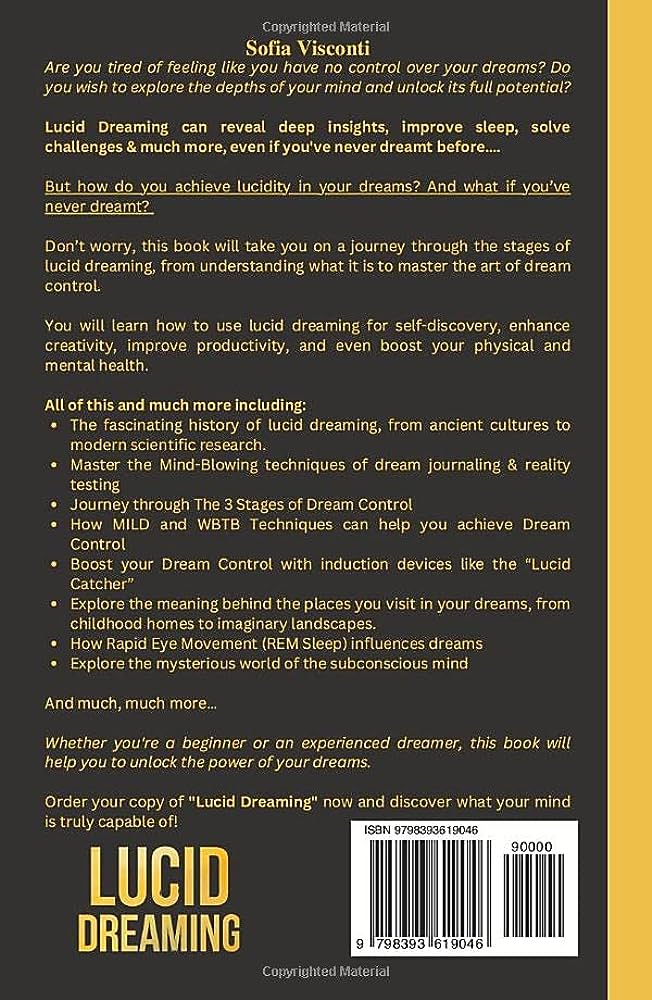Lucid dreaming is a fascinating phenomenon that allows you to become aware that you are dreaming and take control of your dreams. It’s like having a virtual reality experience while you sleep, where you can do anything your imagination desires. In this comprehensive guide, we will explore the world of lucid dreaming, its benefits, and various techniques to help you unlock this extraordinary realm of consciousness.
Understanding Lucid Dreaming
Lucid dreaming occurs during the Rapid Eye Movement (REM) phase of sleep when brain activity resembles that of wakefulness. Unlike regular dreams, where we often passively observe the dream narrative, lucid dreams offer an active, participatory experience.
- Sleep Cycles and REM Sleep: Lucid dreams commonly occur during REM sleep, which typically happens after about 90 minutes of falling asleep.
- Brain Activity during Lucid Dreams: Studies using EEG have shown that lucid dreaming activates regions of the brain associated with self-awareness and decision-making.
- Common Elements in Lucid Dreams: Reality testing, identifying dream signs, and improving dream recall can help induce and sustain lucid dreams.
Preparing Your Mind for Lucid Dreaming
Before diving into the world of lucid dreaming, it’s essential to develop a strong foundation for the practice. Here are some techniques to enhance your lucid dreaming journey:
- Keeping a Dream Journal: Maintaining a dream journal helps improve dream recall, making it easier to recognize patterns and dream signs that indicate you are dreaming.
- Reality Checks: Perform reality checks throughout the day to question whether you are in a dream or reality. Common reality checks include counting fingers or trying to push your finger through your palm.
- Meditation and Mindfulness: Practicing meditation and mindfulness can help increase self-awareness, which is crucial for recognizing when you are in a dream state.
Inducing Lucid Dreams
There are various techniques to induce lucid dreams, and the effectiveness may vary from person to person. Some popular methods include:
- Mnemonic Induction of Lucid Dreams (MILD): This technique involves affirming your intention to have a lucid dream while falling asleep and visualizing yourself becoming aware in a dream.
- Wake-Initiated Lucid Dreams (WILD): In WILD, you maintain consciousness as your body falls asleep, allowing you to transition directly into a lucid dream state.
- Other Induction Techniques: Wake-Back-to-Bed (WBTB) involves waking up in the middle of the night, staying awake for a short period, and then returning to sleep with the intention of lucid dreaming. Some individuals find success with supplements like Galantamine, but it’s essential to research potential side effects before use.
Navigating the Lucid Dreaming Experience
Once you achieve lucidity in a dream, it’s important to stabilize and control the experience. Here are some tips to help you navigate your lucid dreams:
- Stabilizing Lucid Dreams: Engage your senses in the dream environment to prevent the dream from fading. Rubbing your hands together, touching objects, or spinning in the dream can help maintain lucidity.
- Taking Control in Lucid Dreams: Experiment with controlling dream elements, such as flying, summoning objects, or shaping the dream landscape. Practice will enhance your control over time.
- Exploring Inner Realms: Lucid dreams can be an opportunity for self-discovery and introspection. You can meet your dream self, seek wisdom from dream characters, or explore your subconscious mind.
Overcoming Challenges in Lucid Dreaming
While lucid dreaming can be a transformative experience, it’s not without its challenges. Addressing these obstacles is essential for a fulfilling lucid dreaming journey:
- Lucid Dreaming Obstacles: Fear and anxiety can arise when confronted with the vastness of the dream world. Practicing relaxation techniques and reminding yourself that you are in control can help alleviate these emotions.
- Dealing with Nightmares and Sleep Paralysis: Lucid dreaming can provide a powerful tool to transform nightmares into positive experiences. For sleep paralysis, focus on calming your mind and practicing diaphragmatic breathing to ease the sensation.
Advanced Lucid Dreaming Techniques
As you become more adept at lucid dreaming, you can explore more advanced techniques that push the boundaries of dream experiences:
- Time Travel in Lucid Dreams: In lucid dreams, you can travel to the past or future and explore historical events or glimpse into potential outcomes.
- Shared Lucid Dreaming: Some individuals report the ability to engage in shared dreams with other lucid dreamers, opening up new possibilities for connection and exploration.
Integrating Lucid Dreaming into Daily Life
Lucid dreaming doesn’t have to be limited to the realm of sleep. You can use the insights and experiences gained from lucid dreams to enhance various aspects of your waking life:
- Lucid Dreaming for Creativity and Problem-Solving: Engaging in creative pursuits or seeking solutions to real-life problems can be facilitated through lucid dreaming.
- Lucid Dreaming as a Tool for Personal Growth: Lucid dreams provide opportunities for introspection, personal development, and gaining insight into your subconscious thoughts and emotions.
- Using Lucid Dreams for Recreation and Fun: Apart from personal growth, lucid dreaming can be an exciting way to experience adventures, fantasy worlds, and meet your favorite characters.
Ethical Considerations in Lucid Dreaming
While lucid dreaming is a captivating and rewarding experience, it’s essential to consider the ethical implications of your dream actions:
- Respecting Boundaries and Consent: Just as in waking life, it’s important to respect the boundaries and consent of dream characters.
- The Influence of Lucid Dreams on Waking Life: Experiences in lucid dreams can have profound effects on your emotions and mindset upon waking. It’s crucial to integrate these experiences responsibly into your daily life.
Frequently Asked Questions (FAQs)
Here are some frequently asked questions about lucid dreaming:
- What are the potential risks of lucid dreaming? Lucid dreaming is generally considered safe for most individuals. However, some may experience sleep disturbances or become emotionally affected by certain dream experiences.
- Can anyone learn to have lucid dreams? Yes, with practice and dedication, most people can learn to have lucid dreams.
- How long does it take to experience the first lucid dream? The timeline for experiencing the first lucid dream varies from person to person. Some may achieve lucidity within a few weeks, while others may take longer.
- Is lucid dreaming the same as astral projection? Lucid dreaming and astral projection are distinct experiences. Lucid dreaming involves becoming aware within a dream, while astral projection is believed to involve the separation of the consciousness from the physical body.
- Can lucid dreaming improve sleep quality? Lucid dreaming does not negatively impact sleep quality and may, in fact, enhance the overall sleep experience for some individuals.
- Are lucid dreams always under the dreamer’s control? While lucid dreams offer control, the level of control can vary. Some dreams may feel effortless to control, while others may require more practice.
- Can lucid dreaming be physically exhausting? Lucid dreaming itself is not physically exhausting, but intense dream activities may affect your emotions upon waking.
- Is lucid dreaming connected to lucid living? Lucid living involves being fully present and aware in waking life, which can complement and enhance the practice of lucid dreaming.
- Can lucid dreaming be used to address recurring nightmares? Yes, lucid dreaming can be a powerful tool to confront and transform recurring nightmares into positive experiences.
- What is the relationship between lucid dreaming and spirituality? Some individuals view lucid dreaming as a means to explore spiritual dimensions or access higher levels of consciousness.
Conclusion
Lucid dreaming is a remarkable journey of self-discovery and exploration, offering endless possibilities within the realm of dreams. By understanding the science, practicing induction techniques, and navigating the dream world, you can harness the power of lucid dreaming to enrich your life in extraordinary ways. As you delve into this inner world, remember to ap learn this here now proach lucid dreaming with curiosity, responsibility, and an open mind, as it holds the potential for profound personal growth and transformation.


Greetings and welcome to my corner of the digital realm! I’m Ethan Harrington, a dedicated and passionate professional in the field of therapy psychology. My journey through the intricate landscapes of the human mind, emotions, and dreams has led me to this point, where I’m excited to share my insights, knowledge, and experiences with you. See this

